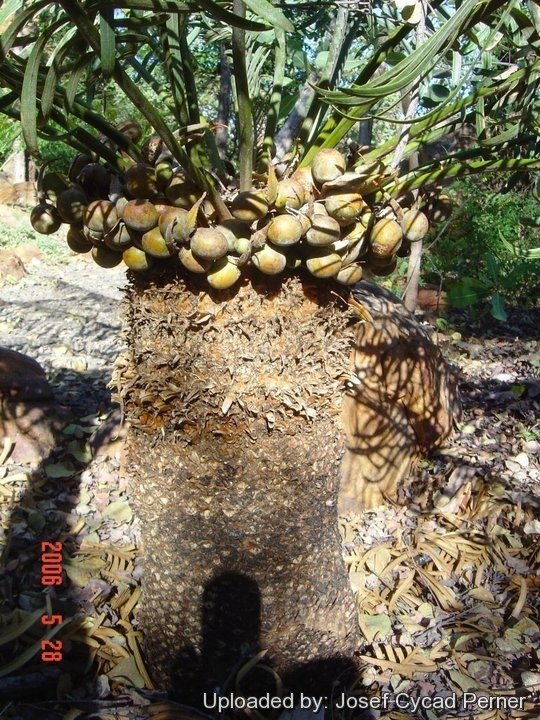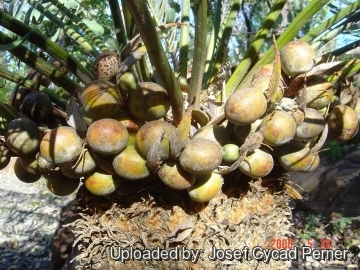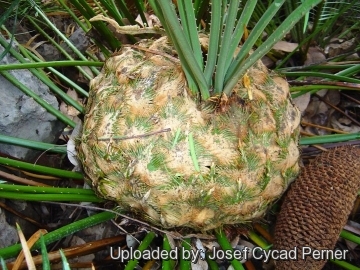




Your support is critical to our success.

Origin and Habitat: Cycas clivicolaSN|31991]]SN|31991]] (ssp. clivicola) is a common species on numerous limestone mountains in Malaysia (Peninsular Malaysia Langkawi and in Perlis state) and on limestone outcrops throughout southern Thailand. This species is best seen on some of the small island outcrops, e. g. near Phang Nga or Pak Meng , but also occurs on inland limestone mountains. It is abundant and widespread in generally inaccessible sites. Cycas clivicolaSN|31991]]SN|31991]] occurs over a wide range (more than 300,000 km²). Also common in gardens in that area, and in cultivation outside of Thailand as `species Araipathet'.
Altitude range: Upper elevation limit 60 metres above sea level.
Habitat and Ecology: This species occurs on limestone outcrops. Plants are most often rooted in clefts and crevices in near-vertical cliffs, in full sun and often with no soil at the roots. These plants grow in the moist monsoon forests which grow around the mountains. The canopy of trees formed the lower limits of the species. In the coastal population they grow closer to the cliff base being limited by the mangroves or the high tides. This species do not establish in the shades of the forest and grow high above them to get full sun. The monsoon forests have a long wet season in which it rain a lot, but plants usually experience droughts in the dry season and temperatures may be very high. There is a weevil that seems to be pollinating the plants as it was found in the male cones which stay long after the are spent. These weevils seem to be nocturnal and there contribution to the pollination is still to be proven as they where not found at the female cones. Although under severe pressure from plant collectors in some areas, it is regarded as stable and still numerous in some extremely inaccessible sites. It is not regarded as threatened. Generation Length 40 years.
Synonyms:
- Cycas clivicola K.D.Hill
Cycas clivicola K.D.Hill
Brittonia 51: 62 (1999)
Accepted name in llifle Database:
Cycas clivicola subs. lutea K.D.Hill
Brittonia 51: 64 (1999)
ENGLISH: Cliff Cycad, Mountain Cycad, Cycad
AFRIKAANS (Afrikaans): Broodboom
Description: Cycas clivicolaSN|11194]]SN|31991]] (Also known as "The Cliff Cycad") is a fairly recently described species from the limestone outcrops and cliffs of Thailand and Malaysia. It is a medium sized cycad to about 8 m tall, with a grey or yellowish coloured trunk (subsp. lutea). The trunk is smooth with a nicely rounded base. Its leaves are bright green or grey-green in colour and most wonderful. The smooth trunks and relatively small male cones with very small microsporophylls and thickened axes distinguish this species within Thailand. Although widespread and abundant, this species remained unnamed until the late 90's. Considerable variation occurs across its range, both within and between populations, but it is fairly clearly a single species. Two geographically separated subspecies are recognised: subsp. clivicola and subsp. lutea.
Related species: It was previously thought to be a form of Cycas pectinataSN|28863]]SN|28863]] or Cycas siamensisSN|31991]]SN|11194]].
Derivation of specific name: C. clivicola derives its name from the Latin clivis, a cliff, and the Latin suffix, -cola, a dweller, in reference to the fact that this plant grows in cracks high up in vertical limestone cliff faces.
Stems: Arborescent, cylindrical or tapering toward apex with a somewhat inflated base, often branched from higher up and may occasionally grow to be up to 8m tall and 12-16 cm in diameter at narrowest point. Mostly dangling from the cliff the shear weight of the plant makes it impossible for the stem to grow upright. The leaf bases persist on the stem for up to 30 cm below the apex and below this the stem is smooth and grey.
Leaves: 45-100 in crown, bright green or grey-green (when young), semiglossy, 70-165 cm long, slightly keeled or flat (not keeled) in section with 90-220 leaflets. Leaflets 9-26 cm long and 5-11 cm broad, weakly discolorous,with white tomentum shedding as leaf expands, decurrent for 3-9 mm, narrowed to 1.5-4 mm at base, 7-16 mm apart on rachis. The clear petiole is 15-55cm long, glabrous, unarmed or more or less spinescent,margins flat to slightly recurved; apex acute, spinescent; midrib raised above, raised below. Basal leaflets not gradually reducing to spines, 20-200 mm long.
Cataphylls: The cataphylls (Modified leaf, much reduced and thickened, serving to protect the apical meristem in cycads produced in flushes preceding the emergence of cones or leaves.) are narrowly triangular, soft, pilose, 50-80 mm long, articulated.
Female cone scales (megasporophylls): Yellow-tomentose to grey-tomentose, 12-22 cm long with the end flattened to form a broad orbicular surface 7-14cm long and 6-9.5cm wide, deeply pectinate, with 24-54 soft lateral spines 25-40 mm long, 1.5-4 mm wide, apical spine distinct from lateral spines, 20-75 mm long, 3-8 mm wide at base.
Male cones: Narrowly ovoid, yellow to brown and even green. They measure 25-50cm long and 8-11 cm wide. The microsporophylls are 1.9-3.5cm long and 1-1.5cm wide, fertile zone 17-30 mm long, sterile apex 2-6 mm long, level, apical spine prominent, sharply upturned or gradually raised, 5-16 mm long.
Seeds: The seeds are flattened-ovoid, 3.5-5cm long and 2.6-3.5cm wide. Sarcotesta orange to yellow, not pruinose, 3-4 mm thick; fibrous layer present; sclerotesta smooth. Spongy endocarp absent.
Subspecies, varieties, forms and cultivars of plants belonging to the Cycas clivicola group
 Cycas clivicola K.D.Hill: has a greyish coloured trunk. The male cones are small with sporophylls less than 25 mm long. Distribution: Malaysia (Peninsular Malaysia); Thailand.
Cycas clivicola K.D.Hill: has a greyish coloured trunk. The male cones are small with sporophylls less than 25 mm long. Distribution: Malaysia (Peninsular Malaysia); Thailand.- Cycas clivicola subs. lutea K.D.Hill: has a yellowish coloured trunk, a feature shared with Cycas pectinata. Male cones larger with sporophylls more than 25 mm long. Distribution: Cambodia; Thailand; Viet Nam.
Notes: This is the species adopted by the Forestry Department of Perlis state (Malaysia) as its official logo.
Bibliography: Major references and further lectures
1) Hill, K.D. 2010. Cycas clivicola. The IUCN Red List of Threatened Species 2010: e.T42074A10619321. http://dx.doi.org/10.2305/IUCN.UK.2010-3.RLTS.T42074A10619321.en . Downloaded on 28 October 2015.
2) Boris Lariushin “Cycadaceae Family” Lulu.com
3) I. Faridah Hanum, Kasim Osman, A. Latiff “Kepelbagaian biologi dan pengurusan Taman Negeri Perlis: persekitaran fizikal dan biologi wang kelian” Jabatan Perhutanan Negeri Perlis, 2001
4) Tang, W “Focus on Cycas clivicola subsp. clivicola” Encephalartos 67: 8-13 2001
5) Haynes J.L, World List of Cycads: A Historical Review, IUCN/SSC Cycad Specialist Group, 2012.
6) The Cycad Pages “Cycas clivicola” Royal Botanic Gardens Sydney Written and maintained by Ken Hill 1998-2010 Maintained by Leonie Stanberg and Dennis Stevenson 2010-2012 <http://plantnet.rbgsyd.nsw.gov.au/cgi-bin/cycadpg?taxname=Cycas+clivicola> Web. 29 October 2015.
7) “Cycas clivicola” Cycads.com, Jurassic Garden, A&A Cycads and Maurice Levin 2001-2013 <http://www.cycadpalm.com/cycasclivicola.html> Web. 29 October 2015.
8) PACSOA contributors "Cycas clivicola". In: Cycads. Palm and Cycad Societies of Australia (PACSOA). 23 November 2013 Web. 29 October 2015.
9) “Cycas clivicola” EcoPort <http://ecoport.org/ep?Plant=365875&entityType=PL****&entityDisplayCategory=fullZ> Web. 29 October 2015.
10) Jones, D.L. “Cycads of the World”, 2nd edn. Reed Books, Sydney, Australia. 2002.
11) Whitelock, Loran M., "The Cycads", Timber press, 2002.

Cycas clivicola Photo by: Josef Cycad Perner

Cycas clivicola Photo by: Josef Cycad Perner

Cycas clivicola Photo by: Josef Cycad Perner

Cycas clivicola Photo by: Josef Cycad Perner
Cultivation and Propagation: Popularly sought by collectors for sale but currently not very common in cultivation the Cliff Cycad (Cycas clivicolaSN|31991]]SN|31991]]) is suited to tropical regions which have a seasonally dry climate. It is easy to grow, tolerating dry periods. It needs full sun in a well drained, alkaline soil/potting mix.
Growth rate: Usually slow growing, however good conditions can speed it up considerably. Because of its growth habit, fertilize only when terminal bud begins to swell, indicating the start of the annual growth cycle.
Exposure: It prefers full sun; best with some protection from afternoon heat when young.
Soil: Needs a well drained spot, with deep alkaline soil.
Maintenance: Minimal; removal of offsets if desired, removal of spent fronds.
Use: Landscape as cultivated perennial in warm, coastal areas; House-plant or interior-scape, as container plant in cool areas, as well very well suited to bonsai culture.
Propagation: Seed. As a slow growing plant, the seed can take from 6–18 months to germinate. After fertile seeds are collected, they usually need several months of storage before the inner embryo is ready to germinate. Therefore, it is best to clean the seeds of external fruit and set them aside before attempting to propagate the seeds.
| Your Actions | |
|---|---|
| Back to Cycas index | |
| Back to Cycadaceae index | |
 |
Back to Palms And Cycads Encyclopedia index |
Privacy stantement - Terms and conditions - How to cite - About us - Feedback - Donate


